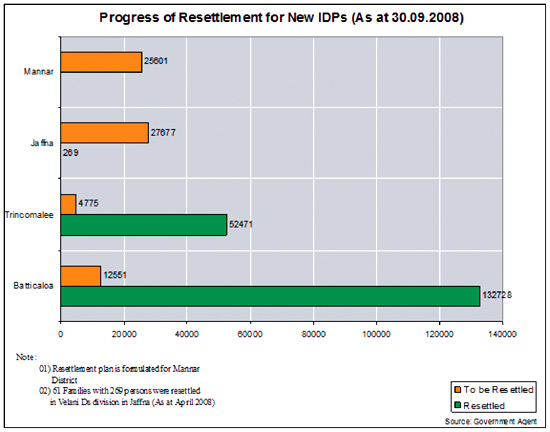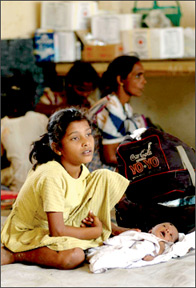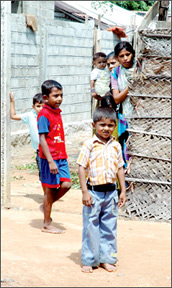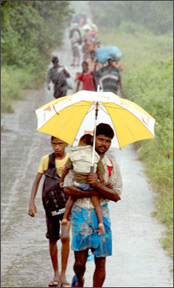Resettlement with dignity
The right to be resettled at their native places
Resettle displaced people either at their native
places or alternative locations
Giving a hand to them to live in dignity
By Dhaneshi YATAWARA
[email protected]

Already 116,050 women, children and men
from the Batticaloa district and 70,353 from Trincomalee
district have been resettled - Ministry of Resettlement.
|
By the time the total Eastern theatre was liberated by our valiant
soldiers from the marauding Tigers, a total of more than 160,000 people
were under the safe wings of the Government and the Security Forces -
staying in the welfare camps hoping to return to their homes and lands.
Some were staying with friends and relatives until the situation turned
normal. The total was almost 200,000. The humanitarian operation was
launched on 26 July, 2006 with the freeing of Mavil Aru anicut and
succeeded in liberating the total Eastern theatre by capturing the
‘Baron’s cap’ summit (Thoppigala) by July 2007.
At the moment after the total liberation of East only 6858 people
from Batticaloa and 9185 people from Trincomalee have to be resettled,
the latest statistics available with the Ministry of Resettlement and
Disaster Relief Services reveal. According to information furnished by
the respective District Secretaries, the total figure 6858 consist of
2703 people from Chenkalady in Eravurpattu and 4155 people from
Koralaipattu North (Vakarai) Batticaloa and 9185 people from Muttur DS
division of Trincomalee, Ministry information further reveals.
The Challenge
Catering to the day-to-day needs of over 160,000 people, victims of
LTTE terrorism, which includes adults as well as children - school
children to toddlers, infants and newly born, is a challenge that cannot
be explained in simple terms. Nutrition, water, healthcare,
sanitation-all come in line with equal priority.
“Some people have escaped only with a few very basic belongings. The
Government had to provide the basics like clothing and Kitchen utensils,
with the support of line ministries, INGOs and many well-wishers,”
Batticaloa District Secretary (GA), Rupawathi Kediswaran added. “Many
people came from the Vakarai area while there were some from Sampoor and
Muttur areas of the Trincomalee district,” she explained.
 |

People living in a welfare centre in Puttlam |

People escaping from LTTE during the East liberation |
Initially these people were sheltered in Schools but as the schools
needed to start functioning alternative places had to be found. “All the
relevant Government authorities joined together and are still involved
in our efforts to look after these people,” GA Kediswaran said.
The Office of the Deputy Provincial Director of Health Services
conducted medical clinics in addition to the medical camps conducted by
the Army. The Provincial Council took care of the sanitary facilities of
these camps. The Ceylon Electricity Board assisted in providing
electricity to the camps.The Water Supply and Drainage Board took the
responsibility of providing drinking water to these people in addition
to the support extended by some INGOs in providing drinking water. Once
in every two weeks dry rations are provided to these people, which
include rice, flour, oil, dhal, sugar and non-food items like soap and
other essential items. According to official statistics in the
Batticaloa district 95% of the de-mining is complete. Hence, the
resettlement can progress, meeting its scheduled targets. In the Mannar
district demining programs are initiated by the Government in
collaboration with the Security Forces, specially in the earlier
liberated Silavathura area.
It is the President Mahinda Rajapaksa’s decision to reawaken the East
as a land of harmony where peace and prosperity are strongly bonded
together. It was under his command our Security Forces marched forward
to liberate the East and continue to do so in the North. Already 116,050
women, children and men from the Batticaloa district and 70,353 from
Trincomalee district are resettled, Ministry statistics and data
state.The challenge is never going to be less but in fact tougher with
the liberation of the Northern Province becoming a reality.
New IDPs
People who were displaced after 2006 are categorized as new
Internally Displaced People.
According to the statistics available up to 16 October, a total of
2791 people are staying within the district of Ampara and another 1024
people outside the district - all of them are staying with friends and
relatives.Not a single welfare camp exists in the Ampara district. In
Mannar district two welfare camps are functioning in Mannar and Nanattan
DS divisions comprising 516 people and outside the district 745 people
are living in welfare camps. And 7499 people are living with friends and
relatives within Mannar as well as out side districts. In addition,
another 2068 economically affected families are benefitted by the
Government through the Ministry of Resettlement.
According to the latest available data, a total number of 76,113
people are living in welfare camps as well as with families and friends
in Jaffna, Kilinochchi, Mulaitivu, Mannar and Vavuniya districts who are
totally taken care of, by the Government. Though the LTTE is forcibly
holding most of these displaced people in Kilinochchi and Mullaitivu
districts, the Government on its part still provides the necessary food
and non-food relief items to them. The GA’s convoys as well as WFP
containers carry these items continuously to those trapped in these two
districts. In Puttalam 16150 are living as displaced people, mainly the
Muslim community whom the LTTE forcefully evicted from Jaffna during its
brutal ethnic cleansing attempt in 1990. Other displaced people are
living in small numbers in many parts of the country, specially in areas
like Anuradhapura and Polonnaruwa under the care and protection of the
Ministry of Resettlement.
Stocks till Year end
The Ministry of Resettlement based on GAs estimates provides rice,
flour, sugar and dhal to all these displaced people. “We have already
supplied the total food requirements sufficient till end of this year
through respective District Secretaries,” Secretary to Ministry of
Resettlement and Disaster Relief Services, A. C. M. Razik said. “The
resettlement plans for the recently liberated areas are ready. We are
waiting for the clearance certificates from the Security Forces,” Razik
said. “We are planning to resettle people in those areas after
establishing all the infrastructure facilities. This includes repairing
wells for drinking water and setting up water supply schemes,
reconstruction of roads and other infrastructure facilities including
Government institutions,” he further explained.
Objective
Displaced people are living in welfare centres mainly due to the
unsettled conditions existing in the Northern and Eastern parts of the
country. The Ministry of Resettlement regularly maintains these welfare
centres and looks after the refugees with much care.Basic methodology of
resettlement is to relocate displaced people either at their native
places or other alternative places on their consent. However, it has
become difficult to implement resettlement process as an accelerated
program until the landmines are removed from the security zones and
other places when the war situation has eased. Therefore, at present
displaced people are continuously resettled at alternative places opted
by them. However, the right to be resettled at their native place and
also the possession of their properties is always with these displaced
people.Giving land to them to live in dignity has become the main task
of the resettlement process. Before implementing the resettlement
program the economic, social and infrastructural facilities should be
provided. Accordingly, in the first phase restoring roads, hospitals,
schools and office buildings, electricity, market facilities and water
supply are necessary. In the second, the construction and repairs to
other buildings and houses are to be carried out.
When resettling people either at their native place or at alternative
places steps are taken to provide economic and social facilities and to
carry out this process protecting their rights according to the internal
standards. Necessary action is taken jointly with the UNHCR, the UNICEF
and the Human Rights Commission.
It is the responsibility of all citizens of the country to avoid
discrimination between displaced people and the host societies treating
the displaced people as a part of the society. In resettlement process
action is taken to avoid such discrimination.
*****************
Domestic Funded Projects
* Water & Sanitation
Financial provision has been made for water supply, provision of
toilets and drainage facilities in 7 districts totalling Rs. 16.02
million. These projects were implemented by the respective District
Secretaries and in Puttalam by the Commissioner General of the
Secretariat for Northern Displaced Muslims.
Rehabilitation of Access Roads to IDP villages Financial provision
has been made for rehabilitation of access roads to the IDP villages in
six districts at an amount of Rs. 74.93 million. These projects were
implemented by the respective District Authorities.
* Power & Energy
Electricity supply to the resettled villages was an important need
for the returnees could restart their new life and also use power and
energy to engage in new industrial and socio economic development. This
Ministry has prioritized 6 districts and allocated Rs. 9.82 million.
* Education
Education of the children of the displaced families was also one of
the sectors that has been affected during the last 2 decades. Most of
the school infrastructure facilities were destroyed and as such needed
buildings and equipment afresh. The Ministry has allocated Rs. 67.44
million for education sector in 9 districts. The Ministry has
constructed 5 new schools at Karambe-B, Manalkundu, Thambapanni,
Kandalkuda and Umarapath in Puttalam district.
* Livelihood
The resettled IDPs who were engaged in fishing as their occupation
had lost all the fishing equipment they possessed. Therefore, this
Ministry identified some of the affected fishermen and supplied them
with fishing nets and lagoon canoes.The fishermen, who were affected
during the Pesalai- Mannar conflict this year were also partially
compensated in re-equiping them with fishing nets and necessary
equipment. Rs. 4.75 million was allocated for 2 Districts.
Fishermen in Mannar and Vavuniya districts were supplied with fishing
nets and equipment worth over Rs. 2 million under the Mahinda Chinthana
programme.
The livelihood project for IDPs included Vocational Training Centre
for women in sewing and vocational Training for male in driving,
training programme in Information Technology to the educated unemployed
IDP youths and Revolving Loan Fund for Micro Credit. A total amount of
Rs.46.11 million has been allocated for 13 districts.
In 50 sewing training centres 1000 unemployed young girls were
trained.
Those who completed sewing training program were supplied with sewing
machines enabling them to commence self employment on their own. |

